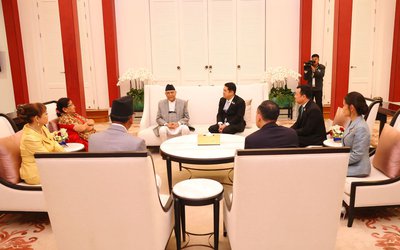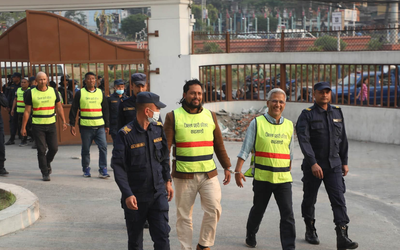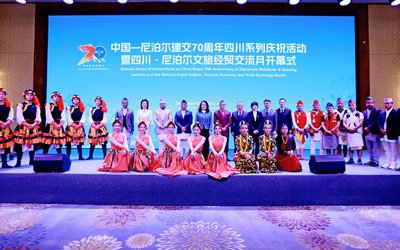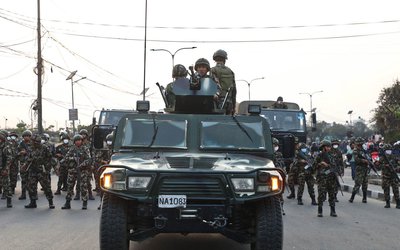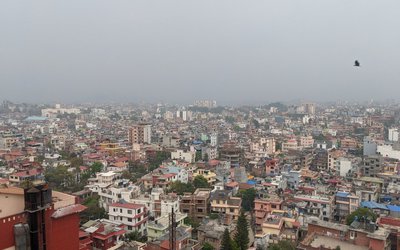
At a time when everyone has been talking about the dim picture of Nepal’s development projects, Nepal Climate Change Support Program (NCCSP) has shown that there is a way to implement the project successfully.
With the support of the local communities, NCCSP has launched several programs in the remote parts of Nepal to reduce the risk of climate change and adopt ways to deal with the changing climate.
For its successful model, the project has received several awards in the past. In the last Paris Conference, the NCCSP was recognized as one of the best programs for community based adaptation.
Nepal Climate Change Support Program (NCCSP) received People's Champion Award and three Photos received Honorable Mentions of Adaptation Fund’s 2016 Global Photo Contest held in New York.
In the Adaptation Fund’s 2016 Global Photo Contest promoting “Coastal and Watershed Adaptation to Climate Change” launched on the coinciding occasion of Earth Day and Paris Climate Agreement Signing Ceremony held on April 22, 2016 in New York, Nepal Climate Change Support Program (NCCSP) received the most appreciation by general public and is awarded with ‘People’s Champion’ for its adaptation photo titled “Power of Unity to Build a Dam”.
The winning photo portrays local communities constructing a dam for an irrigation canal in Lalpur ward no -1 of Khairichandanpur Village Development Committee within the Bardiya district of Midwestern Nepal. Nepal's photo was the most appreciated one among 127 photos submitted globally.
Similarly, out of eight juried Honorable Mentions, three photos portraying inland watersheds impacts and adaptation solution were from Nepal. These winning photos will appear in a dedicated album on the Adaptation Fund’s Flickr site and will also be displayed at the Fund’s upcoming Global Climate Finance Readiness Seminar at the World Bank in Washington DC July 13-15.
The NCCSP is being implemented by Nepal Government, Ministry of Population and Environment in 90 VDCs and 7 Municipalities of 14 districts of Far and Midwestern region of Nepal. The main objective of this program is to build adaptive capacity of most poor, vulnerable and marginalized community against negative impact of climate change. DFID Nepal, EU are providing financial support while UNDP is proving technical support to the program.
“We have been launching LAPA at local level. This award encourages us to do more work. We keep working on adaptation work for poor and vulnerable people. As Nepal is a chair of Adaptation Fund Board, I am very happy to see Nepal’s adaptation program getting international recognition,” said Naresh Sharma, head of Climate Finance Management Section and NAP coordinator.
“NCCSP also recognized earlier at the international level. It is a matter of satisfaction for us to say that these photos will be exhibited again in coming UNFCCC COP 22 in Morocco to show the successful model of local adoption program to the global audience,” said Sharma.
The project covers 14 districts of Nepal - 3 in far-west (Achham, Bajura and Kailali) and 11 in the mid-west (Bardiya, Dolpa, Humla, Jumla, Mugu, Dailekh, Jajarkot, Kalikot, Dang, Rolpa and Rukum). NCCSP aims to ensure the poorest and most vulnerable communities in Nepal adapt to the effects of climate change.
Supported by DFID, European Union and UNDP, Ministry of Population and Environment is implementing this program through the District Development Committees.
This is the first project run with the involvement of various stakeholders, Ministry of Population and Environment, Ministry of Federal Affairs and Local Development, regional offices, VDCs and DDCs, which are implementing LAPA.
According to Ministry of Population and Environment, 100 LAPAs developed in 14 districts of mid and far western regions of Nepal providing technical support to 550,000 women and girls, and 450,000 men and boys with reduced vulnerability due to local adaption and disaster risk reduction actions by 2015.
Over 500,000 vulnerable people, 55% women, have already received access to climate resilient adaptation technology practices.
Similarly, 190,000 women and 170,000 men with access to clean energy technologies, 500,000 people living in VDCs with effective adaptation actions improved gateways to resilience in the last five years.
- IME GROUP: Expands Into Paper Industry
- Mar 24, 2025
- CPN UML: Instigated By India
- Mar 23, 2025
- ADB’S CHIEF ECONOMIST: Nepal Reduces Poverty
- Mar 11, 2025
- FM DR. DEUBA: A Successful Visit
- Mar 11, 2025
- MD GHISING: Target Of Personal Grudge
- Mar 09, 2025

